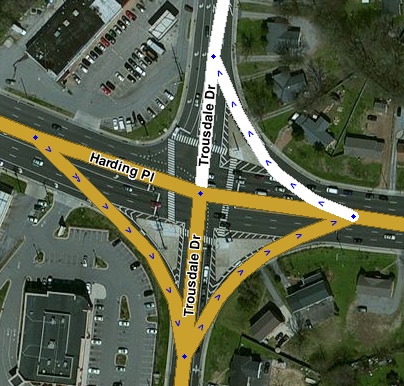When traffic moves between two roads that are at the same grade, these connecting segments are not technically ramps to Waze (unless it falls into one of the Exceptions listed below). How to handle these connectors depends on the exact situation.
Should the connector be mapped?
First and foremost, the need to have the connector mapped needs to be established. As the driver approaches an intersection, Waze has usually given at least one warning that a turn is imminent, and we can assume that the driver is already looking for turn lanes. For most intersections, that is enough to guide the driver into the proper lane and to turn at the proper time; in other words, it is enough that the two roads intersect without separately mapped turning lanes.
There are only a few situations in which connectors are called for in an intersection:
- when the turn lane physically separates from the main road well in advance of the intersection;
- when the ramp is far enough from the point of intersection on the map (due to the size of the intersection or the angle at which the roads meet) that the driver might overshoot while waiting for a delayed "turn" audible, or that the Waze client might become confused and disrupt navigation
- when the area is "busy" enough that the driver may not get any advance warning that a turn is coming up--in which case a ramp lets you notify the driver a little earlier
- As an Area Manager, when you get a user complaint that the audible was too late, or that the map should have shown a ramp
- in the new editor, if resolving map problems of the type 'The roads are too far apart from each other and most likely a road is missing in between'. This problem would be located at an intersection and the GPS tracks show that the turning lane is far enough from the intersection. in some cases the intersection can be reworked to resolve this problem.
When in doubt, leave it out. Each ramp complicates the map and adds to your workload when the time comes to check connectivity, direction, name, etc..
How to label the connector type
Although sometimes referred to as ramps, to Waze these are not ramps. Ramps in Waze should only be used for situations where two roadways have a grade separated intersection.
The connector segment's type should be set based on the lowest of the types of roads it connects.
- Ex: Street to Minor Highway should be Street type.
- Ex: Minor Highway to Primary Street should be Primary Street type.
- Ex: Primary Street to Primary Street should be Primary Street type.
Example:
Also note how the top-left quadrant of the intersection does not have a connector mapped because it does not meet the requirement of being significantly separated from the main intersection.
How to name the connector
In most cases, leaving the segment unnamed will be sufficient. Navigation instructions will simply use the name of the segment to which the connector segment connects.
If there are specific signs at the intersection which are confusing or contrary to the destination road segment name, then a name can be applied to the connector.
Exceptions
Connector is a signed, numbered exit
Example: Garden State Parkway Exit 10 in Cape May Court House, New Jersey, USA. The Garden State Parkway is mostly a freeway class toll-road that runs north/south through New Jersey. As the Parkway approaches its southern terminus, the number of lanes reduce and exits become a mix of grade separated ramps and at-grade intersections.
Going north, the right turn lane is signed as Exit 10B and the left turn lane is signed as Exit 10A (and reversed going south).



